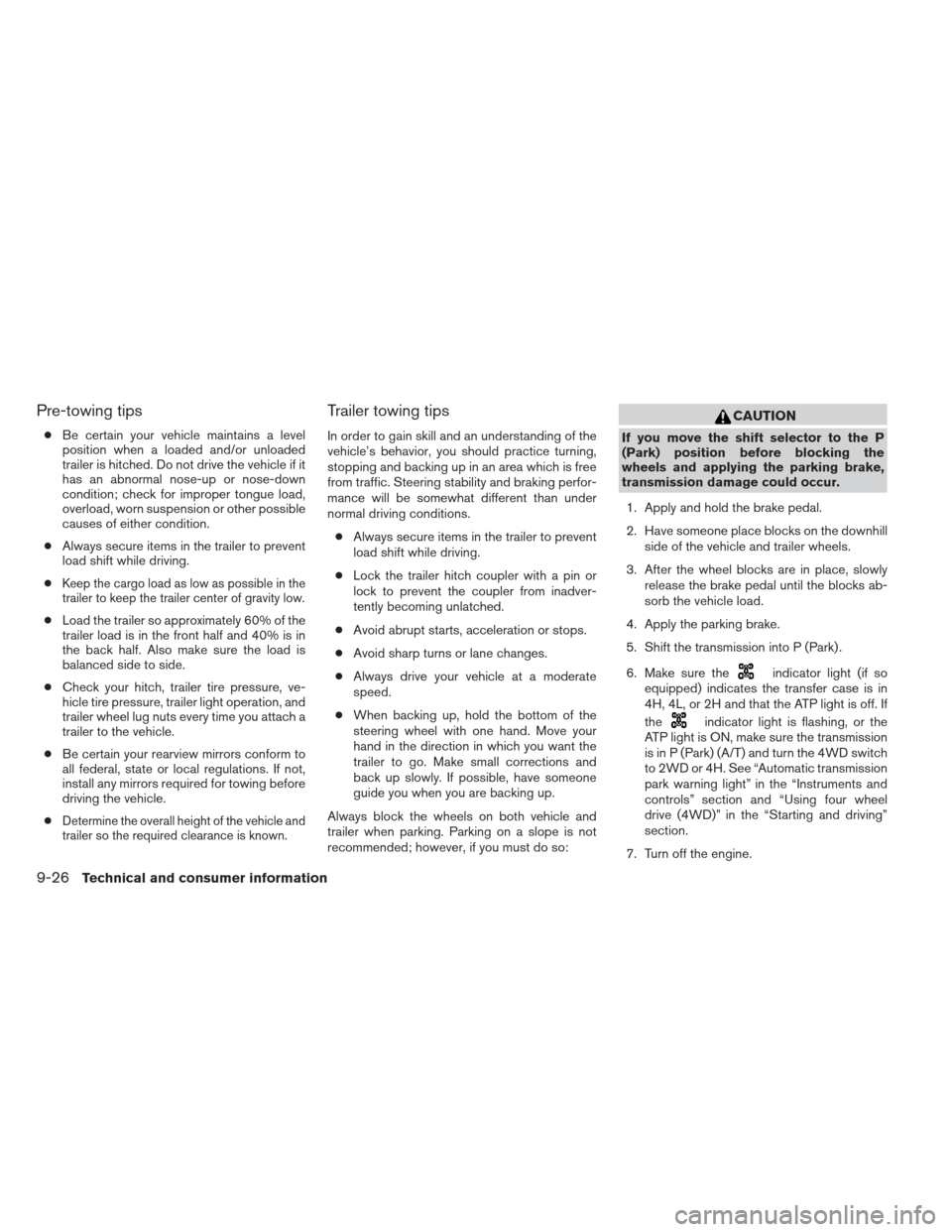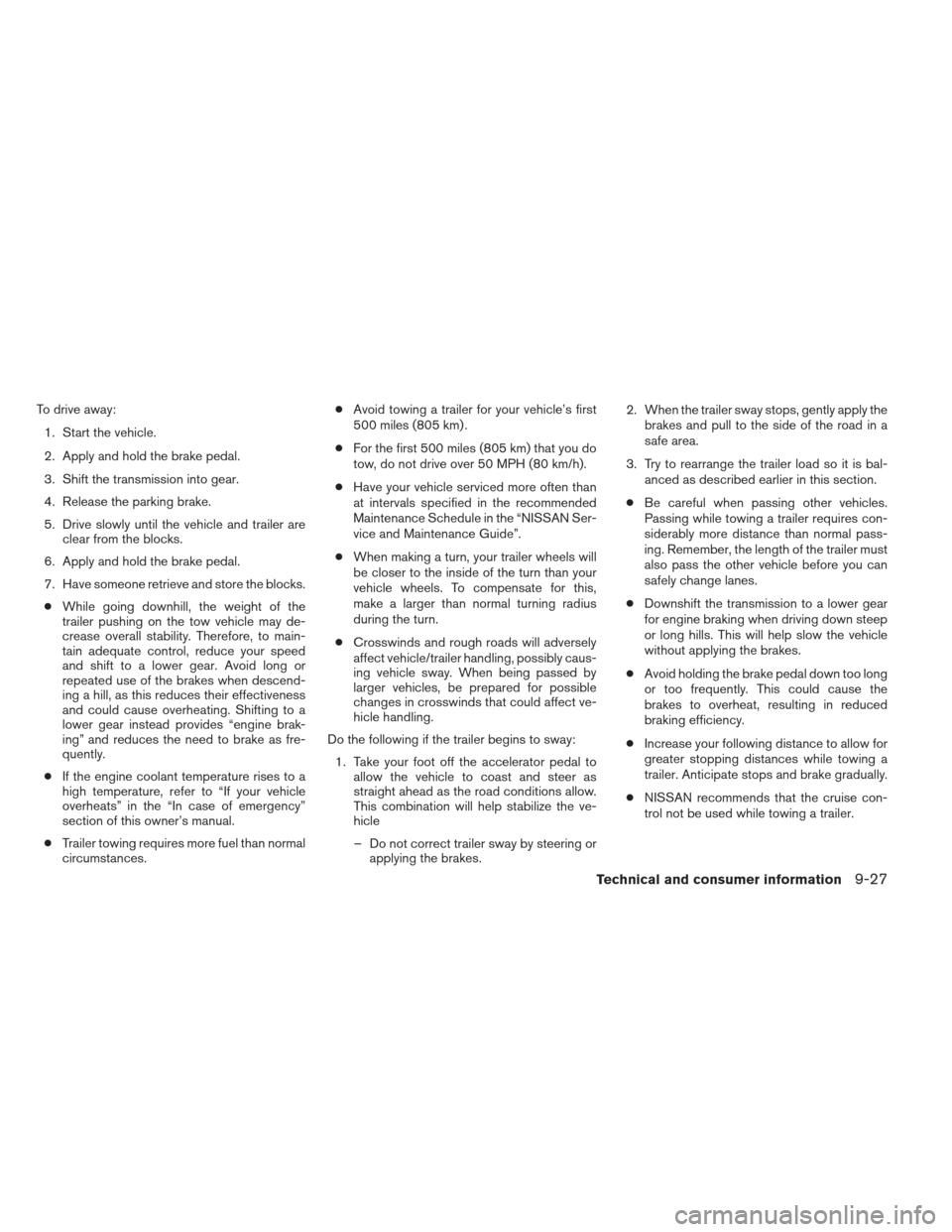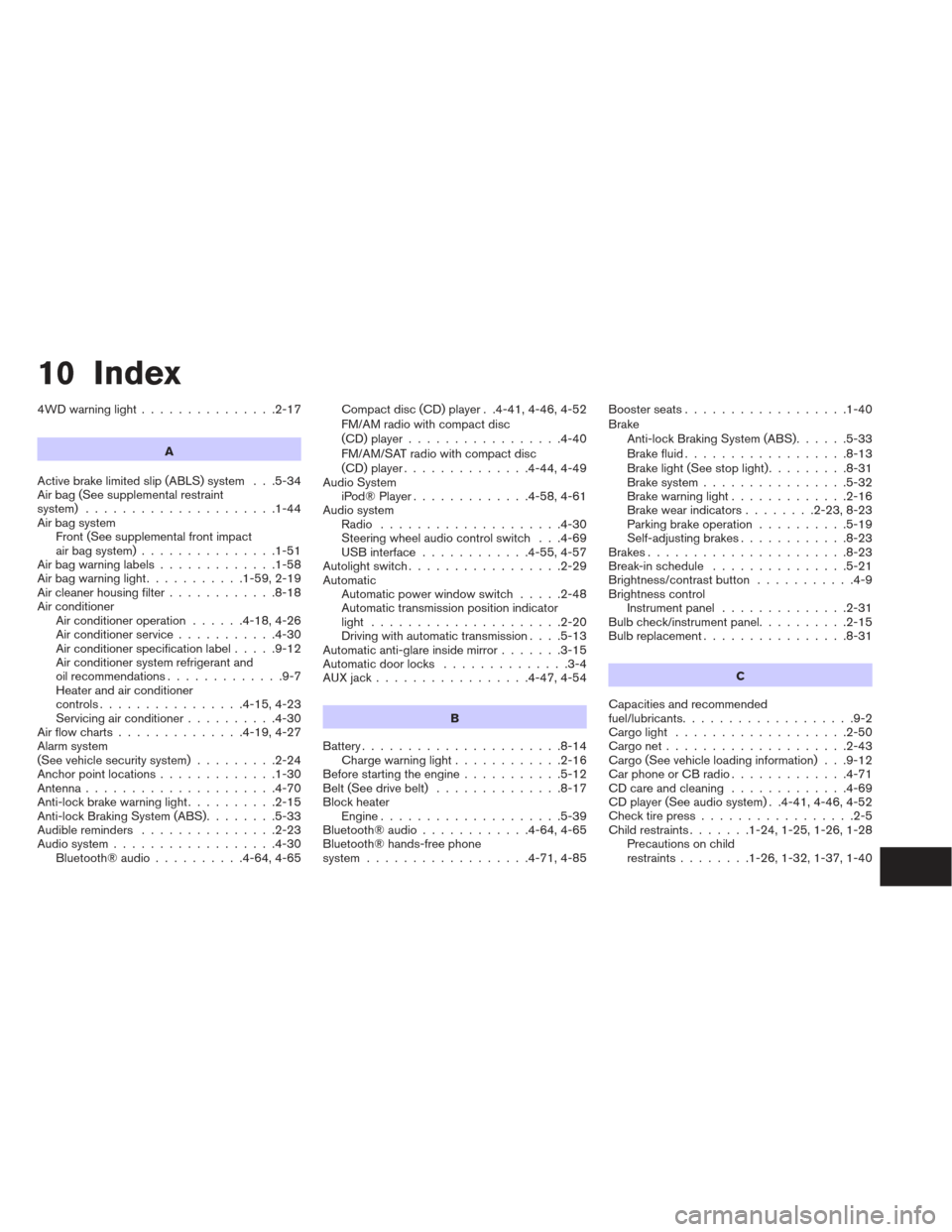2013 NISSAN XTERRA stop start
[x] Cancel search: stop startPage 379 of 394

Pre-towing tips
●Be certain your vehicle maintains a level
position when a loaded and/or unloaded
trailer is hitched. Do not drive the vehicle if it
has an abnormal nose-up or nose-down
condition; check for improper tongue load,
overload, worn suspension or other possible
causes of either condition.
● Always secure items in the trailer to prevent
load shift while driving.
●
Keep the cargo load as low as possible in the
trailer to keep the trailer center of gravity low.
● Load the trailer so approximately 60% of the
trailer load is in the front half and 40% is in
the back half. Also make sure the load is
balanced side to side.
● Check your hitch, trailer tire pressure, ve-
hicle tire pressure, trailer light operation, and
trailer wheel lug nuts every time you attach a
trailer to the vehicle.
● Be certain your rearview mirrors conform to
all federal, state or local regulations. If not,
install any mirrors required for towing before
driving the vehicle.
●
Determine the overall height of the vehicle and
trailer so the required clearance is known.
Trailer towing tips
In order to gain skill and an understanding of the
vehicle’s behavior, you should practice turning,
stopping and backing up in an area which is free
from traffic. Steering stability and braking perfor-
mance will be somewhat different than under
normal driving conditions.
● Always secure items in the trailer to prevent
load shift while driving.
● Lock the trailer hitch coupler with a pin or
lock to prevent the coupler from inadver-
tently becoming unlatched.
● Avoid abrupt starts, acceleration or stops.
● Avoid sharp turns or lane changes.
● Always drive your vehicle at a moderate
speed.
● When backing up, hold the bottom of the
steering wheel with one hand. Move your
hand in the direction in which you want the
trailer to go. Make small corrections and
back up slowly. If possible, have someone
guide you when you are backing up.
Always block the wheels on both vehicle and
trailer when parking. Parking on a slope is not
recommended; however, if you must do so:
CAUTION
If you move the shift selector to the P
(Park) position before blocking the
wheels and applying the parking brake,
transmission damage could occur.
1. Apply and hold the brake pedal.
2. Have someone place blocks on the downhill side of the vehicle and trailer wheels.
3. After the wheel blocks are in place, slowly release the brake pedal until the blocks ab-
sorb the vehicle load.
4. Apply the parking brake.
5. Shift the transmission into P (Park) .
6. Make sure the
indicator light (if so
equipped) indicates the transfer case is in
4H, 4L, or 2H and that the ATP light is off. If
the
indicator light is flashing, or the
ATP light is ON, make sure the transmission
is in P (Park) (A/T) and turn the 4WD switch
to 2WD or 4H. See “Automatic transmission
park warning light” in the “Instruments and
controls” section and “Using four wheel
drive (4WD)” in the “Starting and driving”
section.
7. Turn off the engine.
9-26Technical and consumer information
Page 380 of 394

To drive away:1. Start the vehicle.
2. Apply and hold the brake pedal.
3. Shift the transmission into gear.
4. Release the parking brake.
5. Drive slowly until the vehicle and trailer are clear from the blocks.
6. Apply and hold the brake pedal.
7. Have someone retrieve and store the blocks. ● While going downhill, the weight of the
trailer pushing on the tow vehicle may de-
crease overall stability. Therefore, to main-
tain adequate control, reduce your speed
and shift to a lower gear. Avoid long or
repeated use of the brakes when descend-
ing a hill, as this reduces their effectiveness
and could cause overheating. Shifting to a
lower gear instead provides “engine brak-
ing” and reduces the need to brake as fre-
quently.
● If the engine coolant temperature rises to a
high temperature, refer to “If your vehicle
overheats” in the “In case of emergency”
section of this owner’s manual.
● Trailer towing requires more fuel than normal
circumstances. ●
Avoid towing a trailer for your vehicle’s first
500 miles (805 km) .
● For the first 500 miles (805 km) that you do
tow, do not drive over 50 MPH (80 km/h).
● Have your vehicle serviced more often than
at intervals specified in the recommended
Maintenance Schedule in the “NISSAN Ser-
vice and Maintenance Guide”.
● When making a turn, your trailer wheels will
be closer to the inside of the turn than your
vehicle wheels. To compensate for this,
make a larger than normal turning radius
during the turn.
● Crosswinds and rough roads will adversely
affect vehicle/trailer handling, possibly caus-
ing vehicle sway. When being passed by
larger vehicles, be prepared for possible
changes in crosswinds that could affect ve-
hicle handling.
Do the following if the trailer begins to sway: 1. Take your foot off the accelerator pedal to allow the vehicle to coast and steer as
straight ahead as the road conditions allow.
This combination will help stabilize the ve-
hicle
– Do not correct trailer sway by steering or applying the brakes. 2. When the trailer sway stops, gently apply the
brakes and pull to the side of the road in a
safe area.
3. Try to rearrange the trailer load so it is bal- anced as described earlier in this section.
● Be careful when passing other vehicles.
Passing while towing a trailer requires con-
siderably more distance than normal pass-
ing. Remember, the length of the trailer must
also pass the other vehicle before you can
safely change lanes.
● Downshift the transmission to a lower gear
for engine braking when driving down steep
or long hills. This will help slow the vehicle
without applying the brakes.
● Avoid holding the brake pedal down too long
or too frequently. This could cause the
brakes to overheat, resulting in reduced
braking efficiency.
● Increase your following distance to allow for
greater stopping distances while towing a
trailer. Anticipate stops and brake gradually.
● NISSAN recommends that the cruise con-
trol not be used while towing a trailer.
Technical and consumer information9-27
Page 386 of 394

10 Index
4WDwarninglight...............2-17A
Active brake limited slip (ABLS) system . . .5-34
Air bag (See supplemental restraint
system) .....................1-44
Air bag system Front (See supplemental front impact
air bag system) ...............1-51
Airbagwarninglabels.............1-58
Airbagwarninglight...........1-59,2-19
Air cleaner housing filter ............8-18
Air conditioner Air conditioner operation ......4-18,4-26
Air conditioner service ...........4-30
Air conditioner specification label .....9-12
Air conditioner system refrigerant and
oil recommendations .............9-7
Heater and air conditioner
controls................4-15,4-23
Servicing air conditioner ..........4-30
Airflowcharts..............4-19,4-27
Alarm system
(See vehicle security system) .........2-24
Anchor point locations .............1-30
Antenna.....................4-70
Anti-lock brake warning light ..........2-15
Anti-lock Braking System (ABS) ........5-33
Audible reminders ...............2-23
Audio system ..................4-30
Bluetooth®audio..........4-64,4-65 Compact disc (CD) player . .4-41, 4-46, 4-52
FM/AM radio with compact disc
(CD) player
.................4-40
FM/AM/SAT radio with compact disc
(CD) player ..............4-44,4-49
Audio System iPod®Player.............4-58,4-61
Audio system Radio ....................4-30
Steering wheel audio control switch . . .4-69
USB interface ............4-55,4-57
Autolight switch .................2-29
Automatic Automatic power window switch .....2-48
Automatic transmission position indicator
light .....................2-20
Driving with automatic transmission ....5-13
Automatic anti-glare inside mirror .......3-15
Automatic door locks ..............3-4
AUXjack.................4-47,4-54
B
Battery ......................8-14
Chargewarninglight............2-16
Before starting the engine ...........5-12
Belt (See drive belt) ..............8-17
Block heater Engine ....................5-39
Bluetooth®audio............4-64,4-65
Bluetooth® hands-free phone
system ..................4-71,4-85 Boosterseats..................1-40
Brake
Anti-lock Braking System (ABS) ......5-33
Brakefluid..................8-13
Brakelight(Seestoplight).........8-31
Brake system ................5-32
Brake warning light .............2-16
Brake wear indicators ........2-23,8-23
Parking brake operation ..........5-19
Self-adjusting brakes ............8-23
Brakes ......................8-23
Break-inschedule ...............5-21
Brightness/contrast button ...........4-9
Brightness control Instrument panel ..............2-31
Bulb check/instrument panel ..........2-15
Bulbreplacement................8-31
C
Capacities and recommended
fuel/lubricants ...................9-2
Cargolight ...................2-50
Cargonet....................2-43
Cargo (See vehicle loading information) . . .9-12
CarphoneorCBradio.............4-71
CDcareandcleaning .............4-69
CD player (See audio system) . .4-41, 4-46, 4-52
Check tire press .................2-5
Child restraints .......1-24,1-25,1-26,1-28
Precautions on child
restraints ........
1
-26,1-32,1-37,1-40
Page 390 of 394

On-pavement and off-road driving
precautions..................5-5
Precautions on child
restraints .........1-26,1-32,1-37,1-40
Precautionsonseatbeltusage.......1-13
Precautions on supplemental restraint
system ....................1-44
Precautions when starting and driving ....5-2
Pre-tensioner seat belt system .........1-57
Programmable features ..............4-5
Push starting ...................6-11
R
Radio Car phone or CB radio ...........4-71
FM/AM radio with compact disc
(CD) player ..................4-40
FM/AM/SAT radio with compact disc
(CD) player ..............4-44,4-49
Steering wheel audio control switch ....4-69
Readiness for inspection maintenance
(I/M) test .....................9-31
Rearcenterseatbelt ..............1-19
Rear power windows ..............2-48
RearViewMonitor.................4-9
Rear window and outside mirror defroster
switch .......................2-28
Rear window wiper and washer switches . . .2-27
Recorders Eventdata..................9-32
Refrigerant recommendation ...........9-7
Registering your vehicle in another country . .9-10
Remote keyless entry system ...........3-5
Reporting safety defects (US only) .......9-30Roof rack
.....................2-44
S
Safety Child safety rear door lock ..........3-5
Child seat belts .....1-26,1-32,1-37,1-40
Reporting safety defects (US only) .....9-30
Seat adjustment Frontmanualseatadjustment ........1-2
Seatback pockets ................2-39
Seat belt Childsafety..................1-24
Infants and small children ..........1-25
Injured Person ................1-16
Largerchildren................1-25
Precautions on seat belt usage .......1-13
Pregnant women ...............1-16
Pre-tensioner seat belt system .......1-57
Rear center seat belt ............1-19
Seatbeltextenders .............1-23
Seatbeltmaintenance............1-23
Seatbelts...................1-13
Shoulder belt height adjustment ......1-22
Three-point type with retractor .......1-16
Seat belt warning light ..............2-19
Seats Adjustment ...................1-2
Frontseats...................1-2
Manual front seat adjustment .........1-2
Security indicator light ..............2-22
Security system (NISSAN vehicle immobilizer
system) , engine start ........2-25,3-2,5-11
Self-adjusting brakes ..............8-23
Service manual order form ...........9-32Servicing air conditioner
.............4-30
Setting button ...................4-5
Shifting Automatic transmission ...........5-14
Manual transmission .............5-18
Shiftlockrelease.................5-16
Shoulder belt height adjustment ........1-22
Side air bag system (See supplemental side air
bag, curtain and rollover air bag systems) . . .1-56
Spark plug replacement .............8-18
Speedometer ...................2-4
SRSwarninglabel................1-58
Starting Before starting the engine ..........5-12
Jump starting .................
6
-9
Precautions when starting and driving ....5-2
Push starting .................6-11
Starting the engine .............5-12
Steering Power steering fluid .............8-12
Power steering system ...........5-32
Tilting steering wheel ............3-12
Steering wheel audio control switch ......4-69
Stoplight.....................8-31
Storage......................2-37
Storagebin....................2-41
Storage tray ...................2-37
Sunglasses case .................2-38
Sun visors ....................3-12
Supplemental air bag warning labels ......1-58
Supplemental air bag warning light . . .1-59, 2-19
Supplemental front impact air bag system . . .1-51
Supplemental restraint system Information and warning labels .......1-58
Precautions on supplemental restraint
system ....................1-44
10-5